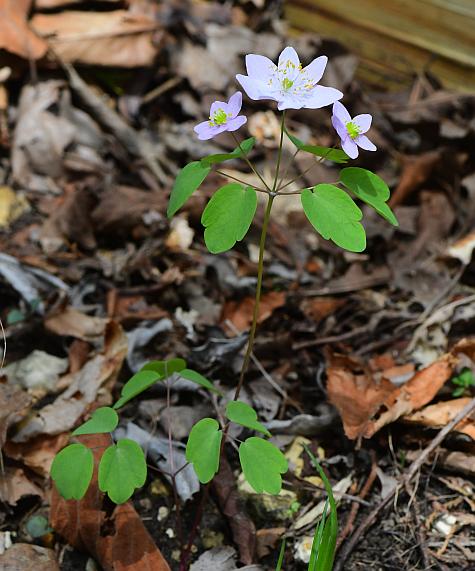Thalictrum thalictroides (L.) A.J. Eames & B. Boivin
Rue-Anemone

Native
CC = 5
CW = 3
MOC = 82
© SRTurner
Thalictrum thalictroides (L.) A.J. Eames & B. BoivinRue-Anemone | |
 |
Native CC = 5 CW = 3 MOC = 82 |
© SRTurner |
|
Family - Ranunculaceae Habit - Perennial forb with swollen and tuberous roots. Stems - Erect, to 25 cm tall, often reddish, thin, single or multiple from base, glabrous. Leaves - Opposite and basal, compound. Stem leaves (technically bracts) opposite at a single node immediately subtending the inflorescence (note that in some cases the leaflets may resemble a whorl of six simple leaves), sessile, once ternately compound (the basal leaves twice ternately compound), the largest leaflets 0.8-2.5 cm long, wider than long to about as long as wide, broadly ovate to obovate, broadly oblong, or nearly circular, 3-lobed, the lobes rounded or broadly and bluntly pointed at the tips, relatively thin and membranous in texture, the margins entire or occasionally scalloped, sometimes slightly thickened or inconspicuously revolute, the undersurface and stalk glabrous and lacking sessile glands.
Inflorescence - Terminal umbel with 3-6 flowers or solitary flowers. Rays to 3 cm long, very thin, glabrous, with a single flower terminating each ray.
Flowers - Sepals 5-7, 5-13 mm long, petaloid, white or pale pink to lavender. Petals absent. Stamens numerous. Filaments to 5 mm long, white, glabrous. Anthers yellow, to 1.5 mm long. Carpels 4-15.
Fruits - Achenes 8-ribbed, to 5 mm long, 2 mm in diameter, narrowly ellipsoid to narrowly ovoid, not appearing stalked, beakless.
Flowering - March - June. Habitat - Upland forests, bluffs, glade margins, streambanks, upland slopes, ridges, roadsides. Origin - Native to the U.S. Lookalikes - Isopyrum biternatum. Other info. - This little plant is common throughout most of Missouri and the eastern half of the continental U.S. It is a characteristic member of the springtime ephemeral flora. Though easily recognized, it is sometimes confused with its lookalike, "false rue anemone" (Isopyrum biternatum), which has similar flowers. They can be differentiated by the following: T. thalictroides inhabits higher, drier ground; has larger flowers which are most commonly tinted a delicate pastel shade and which usually contain more than 5 petaloid sepals; has a single node of bracts subtending the flower(s); and is usually found singly or in small groups rather than in large colonies. With a little practice the distinction will be easily apparent. Photographs taken at Weldon Spring Conservation Area, St. Charles County, MO, 4-6-2011, Valley View Glade Natural Area, Jefferson County, MO, 4-11-2014, Little Lost Creek Conservation Area, Warren County, MO, 3-30-2012 and 4-8-2020, Bootleg Access, Washington County, MO, 4-7-2020, and Meramec State Park, Franklin County, MO, 4-16-2020 (SRTurner). |